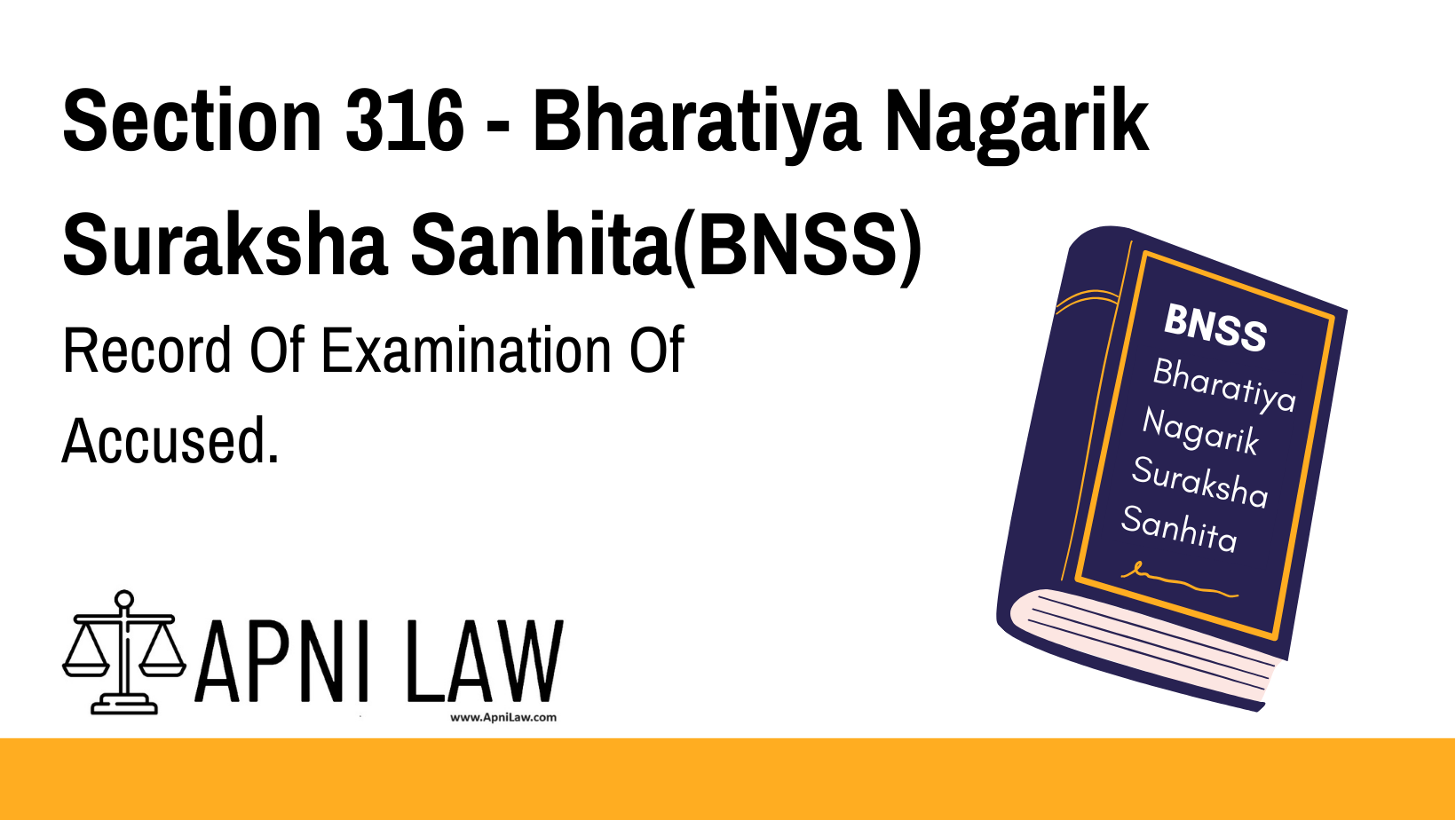ode: Section 316 BNSS
316. (1) Whenever the accused is examined by any Magistrate, or by a Court of Session, the whole of such examination, including every question put to him and every answer given by him, shall be recorded in full by the presiding Judge or Magistrate himself or, where he is unable to do so owing to a physical or other incapacity, under his direction and superintendence by an officer of the Court appointed by him in this behalf.
(2) The record shall, if practicable, be in the language in which the accused is examined or, if that is not practicable, in the language of the Court.
(3) The record shall be shown or read to the accused, or, if he does not understand the language in which it is written, shall be interpreted to him in a language which he understands, and he shall be at liberty to explain or add to his answers.
(4) It shall thereafter be signed by the accused and by the Magistrate or presiding Judge, who shall certify under his own hand that the examination was taken in his presence and hearing and that the record contains a full and true account of the statement made by the accused:
Provided that where the accused is in custody and is examined through electronic communication, his signature shall be taken within seventy-two hours of such examination.
(5) Nothing in this section shall be deemed to apply to the examination of an accused person in the course of a summary trial.
Explanation of Section 316 BNSS
Section 316 BNSS sets out the procedures for recording the entire examination of the accused during a trial or inquiry conducted by a Magistrate or a Court of Session. This section ensures that the recorded testimony is accurate, accessible to the accused, and properly certified. The key aspects include:
- Full Recording of Examination:
The entire examination of the accused—including every question asked and every answer provided—must be recorded in full. If the presiding Judge or Magistrate is unable to record due to physical or other limitations, an appointed officer shall do so under the Judge’s or Magistrate’s supervision. - Language of the Record:
Ideally, the record should be made in the language in which the accused is examined. If that is not feasible, it must be recorded in the language of the Court. This provision aims to ensure that the accused fully understands the proceedings. - Review and Interpretation:
The record must be shown or read to the accused. If the accused does not understand the language in which the record is written, it should be interpreted into a language he understands. Additionally, the accused is allowed to clarify or add to his answers, ensuring his statement is complete and accurately represented. - Certification and Signatures:
After the examination, the record must be signed by both the accused and the presiding Judge or Magistrate. The Judge or Magistrate must certify, under his own hand, that the examination was conducted in his presence and that the record is a complete and true account of the accused’s statements. In cases where the accused is in custody and examined via electronic communication, his signature must be obtained within seventy-two hours. - Exclusion in Summary Trials:
The provisions of Section 316 do not apply to the examination of an accused in the course of a summary trial, thereby distinguishing between the procedures for regular and summary proceedings.
Illustration
Example 1: Standard Examination Recording
In a criminal trial, the accused is examined by a Magistrate. The entire session is recorded by the Magistrate himself. After the examination, the record is read to the accused in his native language, allowing him to clarify any part of his testimony. The record is then signed by both the accused and the Magistrate, who certifies that it is a true and complete account of the examination.
Example 2: Electronic Examination of a Custodial Accused
An accused person, who is in custody, is examined via video conferencing. An appointed court officer records the entire examination under the direction of the presiding Judge. Within seventy-two hours following the electronic examination, the accused’s signature is obtained on the record. The record is subsequently certified by the Judge and becomes a part of the case file.
Common Questions and Answers on Section 316 BNSS
1. Who is responsible for recording the examination of the accused?
- Answer:
The presiding Judge or Magistrate is responsible for recording the entire examination. If they are unable to do so, an officer of the Court, appointed by them, shall record the evidence under their direction and supervision.
2. In what language must the record be maintained?
- Answer:
Ideally, the record should be in the language in which the accused is examined. If that is not practicable, it must be recorded in the language of the Court.
3. What measures are in place to ensure that the accused understands the record?
- Answer:
The record must be shown or read to the accused. If the accused does not understand the language in which it is written, it must be interpreted into a language he understands, and he is allowed to explain or add to his answers.
4. How is the record of the examination validated?
- Answer:
The record is validated by the signatures of both the accused and the presiding Judge or Magistrate. The Judge or Magistrate also certifies under his own hand that the record is a full and true account of the accused’s statement.
5. Does Section 316 apply to summary trials?
- Answer:
No, Section 316 explicitly does not apply to the examination of an accused in the course of a summary trial.
Conclusion
Section 316 BNSS establishes comprehensive safeguards for recording the examination of an accused in criminal proceedings. By mandating a full and accurate record, ensuring language accessibility, and requiring certification and signatures, this section upholds the integrity of the accused’s statement and protects their right to a fair trial. For further legal insights and detailed guidance on evidentiary recording procedures, visit ApniLaw.








